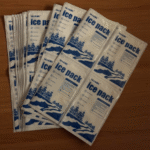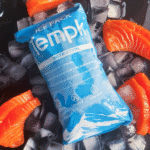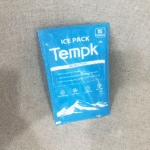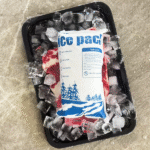The presence of pollution in ice packs mainly depends on their materials and usage. Em alguns casos, if the material or manufacturing process of the ice pack does not meet food safety standards, there may indeed be contamination issues. Here are some key considerations:
1. Composição química:
-Some low-quality ice packs may contain harmful chemicals such as benzene and phthalates (a commonly used plasticizer), which can pose a health hazard. These chemicals may seep into food during use, especially in high temperature environments.
2. Damage and leakage:
-If the ice bag is damaged or leaked during use, the gel or liquid inside may come into contact with food or drinks. Although most ice bag fillers are non-toxic (such as polymer gel or saline solution), direct contact is still not recommended.

3. Product certification:
-When choosing an ice pack, check for food safety certification, such as FDA approval. These certifications indicate that the material of the ice pack is safe and suitable for contact with food.
4. Correct use and storage:
-Ensure the cleanliness of ice packs before and after use, and store them properly. Avoid coexisting with sharp objects to prevent damage.
-Ao usar um pacote de gelo, it is best to place it in a waterproof bag or wrap it with a towel to avoid direct contact with food.
5. Environmental issues:
-Considering environmental protection, reusable ice packs can be chosen, and attention should be paid to the recycling and disposal methods of ice packs to reduce environmental pollution.
Resumidamente, choosing high-quality and appropriately certified ice packs, and using and storing them correctly, can minimize the risk of pollution. If there are special safety concerns, you can have a detailed understanding of product materials and user reviews before purchasing.
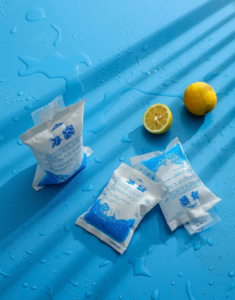
The main components of refrigerated ice packs
Refrigerated ice packs are typically composed of several key materials aimed at providing good insulation and sufficient durability. The main materials include:
1. Material da camada externa:
-Nylon: Leve e durável, commonly used on the outer layer of high-quality ice packs. Nylon has good wear resistance and tear resistance.
-Poliéster: Another commonly used outer layer material, slightly cheaper than nylon, and also has good durability and tear resistance.
-Vinyl: Suitable for applications that require waterproofing or easy to clean surfaces.
2. Material de isolamento:
-Espuma de poliuretano: it is a very common insulating material, and is widely used in refrigerated ice bags due to its excellent thermal insulation performance and lightweight characteristics.
-Poliestireno (EPS) espuma: also known as styrofoam, this material is commonly used in portable cold boxes and some one-time cold storage solutions.
3. Inner lining material:
-Folha de alumínio ou filme metalizado: commonly used as lining material to help reflect heat and maintain internal temperature.
-Peva de qualidade alimentar (polyethylene vinyl acetate): A non-toxic plastic material commonly used for the inner layer of ice bags in direct contact with food, and is more popular because it does not contain PVC.

4. Haste:
-Bolsa de gel: bag containing special gel, which can keep cooling effect for a long time after freezing. Gel is usually made by mixing water and polymer (como poliacrilamida), sometimes preservative and antifreeze are added to improve performance.
-Salt water or other solutions: Some simpler ice packs may only contain salt water, which has a freezing point lower than pure water and can provide longer cooling time during refrigeration.
When choosing a suitable refrigerated ice bag, you should consider whether its material meets your specific needs, especially whether it requires food safety certification, and whether the ice bag needs frequent cleaning or use in specific environments.
The main components of frozen ice packs
Um pacote de gelo congelado normalmente consiste nos seguintes componentes principais, Cada um com funções específicas para garantir que o pacote de gelo congelado mantenha efetivamente baixas temperaturas:
1. Material da camada externa:
-Nylon: Nylon é um durável, impermeável, e material leve adequado para sacos de gelo congelados que requerem movimento frequente ou uso ao ar livre.
-Poliéster: O poliéster é outro material durável comum comumente usado para a concha externa de sacos de gelo congelados, com boa força e resistência ao desgaste.
2. Camada de isolamento:
-Espuma de poliuretano: É um material isolante muito eficaz, e é amplamente utilizado em sacos de gelo congelados devido à sua excelente capacidade de retenção de calor.
-Poliestireno (EPS) espuma: também conhecido como espuma de estireno, Este material leve também é comumente usado em refrigeração e produtos congelados, especialmente em soluções de refrigeração únicas.
3. LINHO INTERNO:
-Folha de alumínio ou filme metalizado: Esses materiais são comumente usados como revestimentos para ajudar a refletir a energia térmica e melhorar os efeitos de isolamento.
-Peva de qualidade alimentar: Este é um material plástico não tóxico comumente usado para a camada interna de pacotes de gelo, Garantir contato seguro com comida.
4. Haste:
-Gel: O enchimento comumente usado para sacos de gelo congelado é gel, que geralmente contém água, polímeros (como poliacrilamida) e uma pequena quantidade de aditivos (como conservantes e anticongelantes). Esses gel podem absorver muito calor e liberar lentamente o efeito de resfriamento após o congelamento.
-Solução de água salgada: Em alguns pacotes de gelo simples, A água salgada pode ser usada como líquido de arrefecimento, porque o ponto de congelamento da água salgada é menor que o da água pura, fornecendo um efeito de resfriamento mais duradouro.
Ao escolher pacotes de gelo congelados, É importante garantir que os materiais do produto selecionados estejam seguros, ecologicamente correto, e pode atender às suas necessidades específicas, como preservação de alimentos ou fins médicos. Enquanto isso, Considere o tamanho e a forma dos pacotes de gelo para garantir que eles sejam adequados para o seu contêiner ou espaço de armazenamento.
















